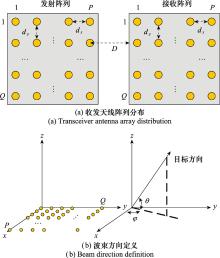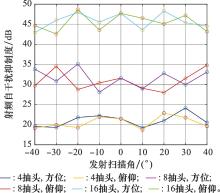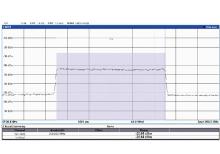Systems Engineering and Electronics ›› 2025, Vol. 47 ›› Issue (1): 307-315.doi: 10.12305/j.issn.1001-506X.2025.01.31
• Communications and Networks • Previous Articles Next Articles
Radio frequency self-interference suppression technology for phased array networking tracking telemetering and command relay with co-frequency
Liu LIU1,2, Tian LIU2, Yang LI3, Wensheng PAN3, Yan ZHANG1,*
- 1. School of Telecommunications Engineering, Xidian University, Xi'an 710071, China
2. The 10th Research Institute of China Electronics Technology Group Corporation, Chengdu 610036, China
3. National Key Laboratory of Wireless Communications, University of Electronic Science and Technology of China, Chengdu 611731, China
-
Received:2023-11-09Online:2025-01-21Published:2025-01-25 -
Contact:Yan ZHANG
CLC Number:
Cite this article
Liu LIU, Tian LIU, Yang LI, Wensheng PAN, Yan ZHANG. Radio frequency self-interference suppression technology for phased array networking tracking telemetering and command relay with co-frequency[J]. Systems Engineering and Electronics, 2025, 47(1): 307-315.
share this article
| 1 |
LIU X P , ZOU Y , MENG Z Y , et al. Coordinated attitude synchronization and tracking control of multiple spacecraft over a communication network with a switching topology[J]. IEEE Trans.on Aerospace and Electronic System, 2020, 56 (2): 1148- 1162.
doi: 10.1109/TAES.2019.2925512 |
| 2 |
ZHAO Z Y , XU G J , ZHANG N , et al. Performance analysis of the hybrid satellite-terrestrial relay network with opportunistic scheduling over generalized fading channels[J]. IEEE Trans.on Vehicular Technology, 2022, 71 (3): 2914- 2924.
doi: 10.1109/TVT.2021.3139885 |
| 3 |
陈刘伟, 梁俊, 朱巍. 基于公平性的星地协作系统分布式中继选择策略[J]. 计算机工程, 2016, 42 (6): 91- 95.
doi: 10.3969/j.issn.1000-3428.2016.06.016 |
|
CHEN L W , LIANG J , ZHU W . Distributed relay selection strategy for satellite-terrestrial cooperative system based on fairness[J]. Computer Engineering, 2016, 42 (6): 91- 95.
doi: 10.3969/j.issn.1000-3428.2016.06.016 |
|
| 4 |
ZENG Y , ZHANG R , LIM T J . Throughput maximization for UAV enabled mobile relaying systems[J]. IEEE Trans.on Communications, 2016, 64 (12): 4983- 4996.
doi: 10.1109/TCOMM.2016.2611512 |
| 5 | 吴高峰, 高晓光, 符小卫. 一种基于多无人机的中继节点布置问题建模与优化方法[J]. 航空学报, 2017, 38 (11): 236- 248. |
| WU G F , GAO X G , FU X W . Modeling and optimization method of relay node placement using multi-UAV[J]. Acta Aeronautica et Astronautica Sinica, 2017, 38 (11): 236- 248. | |
| 6 | 唐友喜. 同时同频全双工原理与应用[M]. 北京: 科学出版社, 2016. |
| TANG Y X . Full duplex principles and applications[M]. Beijing: Science Press, 2016. | |
| 7 |
景小荣, 张翠翠. 多小区全双工MIMO系统中干扰对齐方案[J]. 系统工程与电子技术, 2018, 40 (7): 1615- 1625.
doi: 10.3969/j.issn.1001-506X.2018.07.29 |
|
JING X R , ZHANG C C . Interference alignment scheme for multi-cell full duplex MIMO systems[J]. Systems Engineering and Electronics, 2018, 40 (7): 1615- 1625.
doi: 10.3969/j.issn.1001-506X.2018.07.29 |
|
| 8 | 叶澍, 吉晓东, 李文华. 全双工无人机中继系统物理层安全性能研究[J]. 系统仿真学报, 2022, 34 (4): 788- 796. |
| YE S , JI X D , LI W H . Research on physical layer security of full-duplex UAV relaying[J]. Journal of System Simulation, 2022, 34 (4): 788- 796. | |
| 9 |
肖振宇, 刘珂, 朱立鹏. 无人机机间毫米波阵列通信技术[J]. 通信学报, 2022, 43 (10): 196- 209.
doi: 10.11959/j.issn.1000-436x.2022158 |
|
XIAO Z Y , LIU K , ZHU L P . Millimeter-wave array enabled UAV-to-UAV communication technology[J]. Journal on Communications, 2022, 43 (10): 196- 209.
doi: 10.11959/j.issn.1000-436x.2022158 |
|
| 10 |
XIAO Z Y , XIA P F , XIA X G . Full-duplex millimeter-wave communication[J]. IEEE Wireless Communications, 2017, 24 (6): 136- 143.
doi: 10.1109/MWC.2017.1700058 |
| 11 | CACCIOLA R, HOLZMAN E, CARPENTER L, et al. Impact of transmit interference on receive sensitivity in a bi-static active array system[C]//Proc. of the IEEE International Symposium on Phased Array Systems and Technology, 2016. |
| 12 | EVERETT E , SAHAI A , SABHARWAL A . Passive self-interference suppression for full-duplex infrastructure nodes[J]. IEEE Trans.on Wireless Communications, 2013, 13 (2): 680- 694. |
| 13 | MAKAR G , TRAN N , KARACOLAK T . A high isolation monopole array with ring hybrid feeding structure for in-band full-duplex systems[J]. IEEE Antennas & Wireless Propagation Letters, 2017, 16, 356- 359. |
| 14 |
SHI C Z , PAN W S , SHEN Y , et al. Robust transmit beamforming for self-interference cancellation in STAR phased array systems[J]. IEEE Signal Processing Letters, 2022, 29, 2622- 2626.
doi: 10.1109/LSP.2022.3229641 |
| 15 |
BARNETO C B , LIYANAARACHCHI S D , HEINO M , et al. Full duplex radio/radar technology: the enabler for advanced joint communication and sensing[J]. IEEE Wireless Communications, 2021, 28 (1): 82- 88.
doi: 10.1109/MWC.001.2000220 |
| 16 |
KOLODZJEJ K E , DOENE J P , PERRY B T , et al. Adaptive beamforming for multi-function in-band full-duplex applications[J]. IEEE Wireless Communications, 2021, 28 (1): 28- 35.
doi: 10.1109/MWC.001.2000203 |
| 17 | 徐强, 全欣, 潘文生, 等. 同时同频全双工LTE射频自干扰抑制能力分析及实验验证[J]. 电子与信息学报, 2014, 36 (3): 662- 668. |
| XU Q , QUAN X , PAN W S , et al. Analysis and experimental verification of RF self-interference cancelation for co-time co-frequency full-duplex LTE[J]. Journal of Electronics & Information Technology, 2014, 36 (3): 662- 668. | |
| 18 | 王俊, 赵宏志, 卿朝进, 等. 同时同频全双工场景中的射频域自适应干扰抵消[J]. 电子与信息学报, 2014, 36 (6): 1435- 1440. |
| WANG J , ZHAO H Z , QING Z J , et al. Adaptive self-interference cancellation at RF domain in co-frequency co-time full duplex systems[J]. Journal of Electronics & Information Technology, 2014, 36 (6): 1435- 1440. | |
| 19 |
LI C X , ZHAO H Z , WU F , et al. Digital self-interference cancellation with variable fractional delay FIR filter for full-duplex radios[J]. IEEE Communications Letters, 2018, 22 (5): 1082- 1085.
doi: 10.1109/LCOMM.2018.2810270 |
| 20 |
HE M , HUANG C . Self-interference cancellation for full-duplex massive MIMO OFDM with single RF chain[J]. IEEE Wireless Communications Letters, 2020, 9 (1): 26- 29.
doi: 10.1109/LWC.2019.2940433 |
| 21 |
AHMED E , ELTAWIL A . All-aigital self-interference cancellation technique for full-duplex systems[J]. IEEE Trans.on Wireless Communications, 2015, 14 (7): 3519- 3532.
doi: 10.1109/TWC.2015.2407876 |
| 22 |
秦焕丁, 孟进, 何方敏, 等. 多抽头结构的宽带射频干扰对消及优化设计[J]. 系统工程与电子技术, 2023, 45 (9): 2681- 2689.
doi: 10.12305/j.issn.1001-506X.2023.09.05 |
|
QIN H D , MENG J , HENG F M , et al. Performance and optimization design of wideband RF cancellation based on multi-tap structure[J]. Systems Engineering and Electronics, 2023, 45 (9): 2681- 2689.
doi: 10.12305/j.issn.1001-506X.2023.09.05 |
|
| 23 |
KWAK J W , SIM M S , KANG I W , et al. Analog self-interference cancellation with practical RF components for full-duplex radios[J]. IEEE Trans.on Wireless Communications, 2023, 22 (7): 4552- 4564.
doi: 10.1109/TWC.2022.3227104 |
| 24 |
HO-VAN K , DO-DAC T . Joint effects of non-linear energy harvesting, primary interference, and full-duplex destination-assisted jamming on spectrum sharing networks[J]. Wireless Networks, 2023, 29 (1): 221- 234.
doi: 10.1007/s11276-022-03119-1 |
| 25 |
PRASAD D V S , SINGH H V , TRIPATHI S , et al. Dual-band full-duplex antenna with high isolation using differential fed and dual-polarization[J]. Microwave and Optical Technology Letters, 2023, 65 (1): 192- 203.
doi: 10.1002/mop.33452 |
| 26 |
KURT A , SALMAN M B , SARAC U B , et al. An adaptive-iterative nonlinear interference cancellation in time-varying full-duplex channels[J]. IEEE Trans.on Vehicular Technology, 2023, 72 (2): 1862- 1878.
doi: 10.1109/TVT.2022.3208766 |
| 27 | WANG J , WANG C X . Self-attention relational modeling and background suppression for weakly supervised temporal action localization[J]. Journal of Electronic Imaging, 2022, 31, 063019. |
| 28 | DONG Q Q, AUSTIN A C M, SOWERBY K W. Neural network model-based self-interference cancellers for true full-duplex systems[C]//Proc. of the IEEE International Symposium on Antennas and Propagation, 2022. |
| 29 |
ELSAYED M , AZIZ EL-BANNA A A , DOBRE O A , et al. Full-duplex self-interference cancellation using dual-neurons neural networks[J]. IEEE Communications Letters, 2022, 26 (3): 557- 561.
doi: 10.1109/LCOMM.2021.3136030 |
| 30 | 翟江鹏, 陈细秋, 马牧远. 全双工相控阵天线收发隔离分析[J]. 河北省科学院学报, 2022, 39 (3): 41- 44. |
| ZHAI J P , CHEN X Q , MA M Y . Analysis of transmit-receive isolation in full-duplex phased array antenna systems[J]. Journal of the Hebei Academy of Science, 2022, 39 (3): 41- 44. |
| [1] | Hai LI, Yutong CHEN, Yu XIONG. Simulation of meteorological target echo of airborne dual-polarization phased array weather radar [J]. Systems Engineering and Electronics, 2025, 47(1): 117-125. |
| [2] | Yongfang ZHANG, Jingyu GAO, Juan LIU. Single reference element rotating-element electric-field vector method for phased array antenna calibration [J]. Systems Engineering and Electronics, 2024, 46(5): 1525-1534. |
| [3] | Lisha ZHENG, Dongliang YIN, Xuan WANG. Operational effectiveness evaluation of phased array radar based on improved D-S evidence theory [J]. Systems Engineering and Electronics, 2024, 46(4): 1330-1336. |
| [4] | Bo CHEN, Wei WANG, Juan LIU, Jianmin JI. Design of satellite-borne low-profile one-dimensional phased scanning slot array antenna [J]. Systems Engineering and Electronics, 2024, 46(10): 3285-3292. |
| [5] | Wei XIU, Chen PANG, Haiyan TIAN, Di WU, Yongzhen LI, Xuesong WANG. Design and implementation of an polarization phased array antenna with high cross-polarization isolation based on liquid crystal [J]. Systems Engineering and Electronics, 2023, 45(7): 1928-1937. |
| [6] | Jingjing ZHU, Shengqi ZHU, Guisheng LIAO, Jingwei XU, Lan LAN, Cao ZENG. Joint target detection based on phased array and frequency diverse array dual-mode radar [J]. Systems Engineering and Electronics, 2023, 45(5): 1342-1350. |
| [7] | Yukun CHEN, Hui YU, Ningyun LU. Fault diagnosis of radar T/R module based on semi-supervised deep learning [J]. Systems Engineering and Electronics, 2023, 45(10): 3329-3337. |
| [8] | Juan LIU, Quanyong SU, Zheng SHI, Xianmou XUE. Optimization design and performance research on microchannel liquid cooling of phased array antenna [J]. Systems Engineering and Electronics, 2022, 44(6): 1782-1788. |
| [9] | Zhanling WANG, Chen PANG, Jiapeng YIN, Yongzhen LI, Xuesong WANG. Polarization control method for wideband phased array based on polarization state configuration [J]. Systems Engineering and Electronics, 2022, 44(3): 795-801. |
| [10] | Wenge XING, Chuanrui ZHOU, Cheng ZHOU. Research on key technology of detection and communication integration for phased array radar [J]. Systems Engineering and Electronics, 2022, 44(10): 3053-3058. |
| [11] | Wei JIANG, Wen SHENG, Wei QI, Shihua LIU. Survey on maintenance decision of large-scale phased array radar's T/R module [J]. Systems Engineering and Electronics, 2022, 44(1): 127-138. |
| [12] | Ziang CHEN, Jiawei YANG, Chenchen TAO. Adaptive monopulse approach under mainlobe jamming of phased array based on GSC [J]. Systems Engineering and Electronics, 2021, 43(8): 2137-2145. |
| [13] | Ao LIU, Zheng ZHOU, Shuangming LI. Phased array radar recognition method based on optimized sequence extraction [J]. Systems Engineering and Electronics, 2021, 43(3): 656-665. |
| [14] | Jisan LI, Wenbin CAI, Lixiang GENG, Rong LIU, Yuan REN. Variable date rate target tracking algorithm for rotating phased array radar [J]. Systems Engineering and Electronics, 2021, 43(3): 676-683. |
| [15] | Wei CHEN, Jijian ZHANG, Wenchong XIE, Yongliang WANG. Research on smart jamming signal model and suppression method for airborne phased array radar [J]. Systems Engineering and Electronics, 2021, 43(2): 343-350. |
| Viewed | ||||||
|
Full text |
|
|||||
|
Abstract |
|
|||||



























